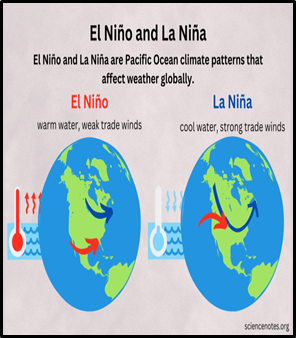IMD PREDICTS ‘ABOVE NORMAL’ MONSOON; LA NIÑA, POSITIVE IOD EXPECTED
Why in the news?
India’s monsoon forecast by the IMD hinges on the transition from El Niño conditions to ‘neutral’ conditions, followed by the onset of La Niña conditions later in the season.
source:slideshare
About El Niño and La Niña Conditions:
- El Niño refers to warmer-than-average temperatures in the Central Pacific, while La Niña signifies cooler-than-average temperatures in the same region.
- El Niño and La Niña are Pacific Ocean climate patterns affecting global weather.
- They result from shifting ocean temperatures in the central and eastern equatorial Pacific.
- Normal Pacific conditions involve westward trade winds and upwelling cold water.
- El Niño disrupts this, bringing warmer temperatures, while La Niña intensifies normal conditions.
- Collectively, they form the El Niño-Southern Oscillation (ENSO) cycle.
About Indian Ocean Dipole (IOD):
Characteristics include:
Three phases: Neutral, Positive, and Negative IOD:
Associated Article: |





